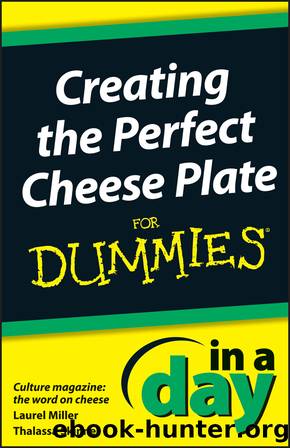Creating the Perfect Cheese Plate In a Day For Dummies by Laurel Miller

Author:Laurel Miller
Language: eng
Format: epub
Publisher: Wiley
Published: 2012-10-26T00:00:00+00:00
Chapter 3
Figuring Out What You Like
In This Chapter
Identifying your cheese preferences
Discovering new varieties of cheese
Have you ever tasted a cheese that just lit up the pleasure center in your brain? Maybe it was the flavor, texture, or both. Perhaps it was in combination with a condiment or beverage. Whatever it was, the taste was like a little slice of heaven, suffusing you with a feeling of well-being.
A large part of the pleasure and experience of eating and appreciating cheese is attributable to its sensory components. Tasting any cheese is a combination of aroma, mouthfeel (the sensation it has on your palate), texture (dry, crumbly, supple, and so on), and flavor. The physical attributes of a cheese play a role, as well.
A number of factors contribute to what you may like or dislike about a certain cheese. In this chapter, we explore what those aspects are and how you can apply them to tasting and learning about cheese. We also provide you with the Cheese Challenge to help you figure out what other kinds of cheeses you might like. Doesnât that sound like fun?
Discovering What You Like and Donât Like
When it comes to choosing, eating, and enjoying cheese, thereâs no right or wrong way to do it. That said, thereâs a whole world of cheese out there, and youâd be doing yourself a disservice by sticking to old standbys.
The key to broadening your cheese horizons and finding new favorites is to figure out just what it is you like in a cheese. The first step is to identify the cheeses â soft or hard â that you love. (Take a look at Chapters 1 and 2 for a variety of cheeses in each of these categories.) Then ask yourself what it is about those cheeses that appeals to you. Focus on the Âfollowing:
The style: Style refers to the type of rind and mold, bacteria, or yeast used to make the cheese, which affects its flavor, texture, and aroma.
The milk: The most common milks used for cheese are cow, sheep, and goat milk. Each, in combination with other factors and ingredients used in the cheesemaking process, impacts the final taste and texture. Do the cheeses you like tend to use one kind of milk over another?
The rind: The rind is essentially the cheeseâs âskin,â and itâs the result of both âgoodâ mold and bacteria and the cheese being exposed to air as it ages. Rinds fall into different categories (natural, surface-ripened, washed, and so on), and they help to create the specific taste and smell associated with a particular type of cheese.
The flavor: How would you describe the flavor of the cheeses that you like? There are many adjectives you can use, but a few terms, like earthy, sharp, buttery, stinky, and nutty, are pretty standard in cheese terminology.
The texture: Texture refers to the consistency or feel of the cheese itself (as opposed to its mouthfeel). Some cheeses are almost rock hard; some are soft as pudding.
Download
This site does not store any files on its server. We only index and link to content provided by other sites. Please contact the content providers to delete copyright contents if any and email us, we'll remove relevant links or contents immediately.
Panini by Carlo Middione(2823)
Sauces by James Peterson(2586)
Tapas Revolution by Omar Allibhoy(2532)
Best of Jane Grigson by Jane Grigson(2466)
Project Smoke by Steven Raichlen(1663)
The Anne of Green Gables Cookbook by Kate Macdonald(1643)
Salad Days by Pam Powell(1547)
Food Processor Perfection by America's Test Kitchen(1521)
Fabulous Party Cakes and Cupcakes by Carol Deacon(1482)
Rise and Shine by Katie Sullivan Morford(1449)
Better Homes and Gardens: Wonder Pot by Better Homes & Gardens(1433)
The Salad Garden by Joy Larkcom(1412)
The Soup Mix Gourmet by Diane Phillips(1378)
Mouthwatering Vegan Burgers by Becky Lawton(1347)
The Perfect Egg: A Fresh Take on Recipes for Morning, Noon, and Night by Teri Lyn Fisher & Jenny Park(1343)
America's Best Ribs by Arthur Aguirre(1308)
America's Best Barbecue by Arthur Aguirre(1283)
Good Food to Go by Brenda Bradshaw(1264)
The Jam and Marmalade Bible by Jan Hedh(1257)
